Samsung G800 review: Camera with a phone
Camera with a phone
Samsung G800 vs. Sony Ericsson K850
As we already said the Samsung G800 and Sony Ericsson K850 may be the primary rivals in the 5-megapixel cameraphone battle among feature phones. The Samsung G800 is indeed more of a digicam that can make calls instead of a regular phone. The K850 offers a more balanced multimedia orientation and is the descendant of a series of highly popular cameraphones that have earned the public trust and appreciation. The Samsung G800 has yet to live up to the challenge.
And since we had the K850 handy we deiced to make a closed 5-megapixel shootout between the two of them. The G800 is not a final retail product, but is really close to that.
Although the contenders are similar in many aspects, there are some important differences we should note right at the beginning. The most prominent difference is of course the optical zoom. Zoom systems are usually a lot more complicated and may prove inferior compared to a fixed optical system when used at the same focal length. The Sony Ericsson K850 lens is wider than the widest position of the G800 zoom, so you will see that in all shots the subjects on the G800 photos look a bit bigger.
Another great difference is the lack of EXIF information in the G800 JPG photos. It was quite an unpleasant surprise, because the EXIF is of great value when trying to figure out what went wrong in a certain test. Again, this is a beta issue and we are quite sure it will be resolved in the market version.
And finally another concern - when set at the highest quality, the Samsung G800 produces files about twice the size of K850. It's not a bad thing to capture as much detail as possible, but a 2.5 MB file from a 5MP cameraphone is just too much.
Camera interface and features
Having the right user interface is essential for an ambitious cameraphone - and for any point-and-shoot digital camera for that matter. Both the Sony Ericsson K850 and the Samsung G800 offer all the basic settings, plus a few advanced options. Both handsets feature image stabilization, Macro mode and an option to turn auto focus off. White balance settings, the usual color effects, exposure compensation and ISO setup are available in both devices. The Samsung G800 offers sensor sensitivity values as low as ISO 50, while the Sony Ericsson K850 lowest setting is ISO 100. However, we didn't like the fact that there is no shortcut for adjusting the exposure compensation on the G800. The exposure compensation is an important setting and should be readily available if you want to make the best of it.
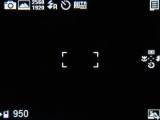

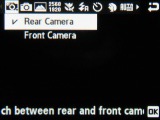

Samsung G800 camera user interface
Both cameraphones are equipped with xenon flash and offer red-eye reduction, however only the Samsung G800 flash can be permanently set to (always on) fire with each shot. This nice option allows it to be used as a fill flash for backlit scenes. However as our tests proved, the G800 flash is nowhere near the performance of the K850 one.
The Samsung G800 camera viewfinder can show gridlines to help users apply the photography rule-of-thirds when framing. However, the G800 lacks other essential options such as a resetting the photo counter and disabling the image preview, which appears after each shot - two options that the Sony Ericsson K850 does have.
Both cameras use the toolbar layout to present the available camera options, which we find the most convenient. As settings are becoming more and more advanced, obviously there is also a need for a separate Camera Settings menu that stores the least used, but essential settings. Both contenders have those menus but it's what they have stashed there that matters. Unfortunately, we found the Samsung hiding its ISO setting there - a feature, which should have received a place on the settings toolbar. Another inconvenience of the Samsung Settings menus is that all the setups applied won't get saved unless you press the Save button. The Back key is treated as a Cancel button and disables all changes made. The G800 also compromises user-friendliness by the fact that every time you open the Settings Menu you are taken to the options related to the Still Camera though you may currently be using the Camcorder, for example. The K850 takes care of that and show you only the currently relevant settings.
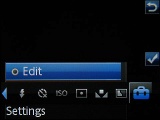
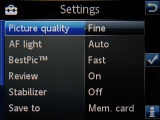

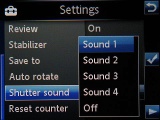
Sony Ericsson K850 settings menu
Now, back to the main options toolbar, we found the Sony Ericsson interface to be more eye-pleasing. It's the last generation of camera interfaces by Sony Ericsson, and it offers some nice eye-candy. Both cameraphones offer tooltips to help users make their way around the settings. This holds especially true for the Samsung G800, which has no labels for the settings available on the toolbar. Hence, an inexperienced user would have to keep the help hints on all the time - at least in the beginning.
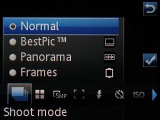
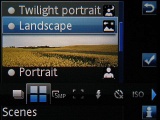
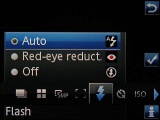

Sony Ericsson K850 toolbar camera menu
For some unknown reason, the first option on the G800 toolbar is toggling between the primary and secondary camera. This is a rarely used setting that is definitely not worth its location. The Mode setting would have made a better first place. At least, the G800 is capable of shooting with the video-call camera - something that the K850 is lacking. However, the K850 remembers the last setting changed and goes straight to it next time (the approach Samsung have with their general phone interface, which we really like), while the G800 presents you with the "Choose camera" menu every time you refer to the settings toolbar.
The Samsung G800 has several advantages over the K850 camera - it features face detection, which works pretty well by looking for eye-and-eyebrow patterns.
The G800 camera interface also allows setting contrast, saturation and sharpness. The wide dynamic range also puts the G800 ahead of K850, although at this point our test shows no visible difference with this option on.
Another advantage is that in Panorama mode the camera can shoot up to 6 images as opposed to Sony Ericsson K850, which makes panoramas out of three shots only. An interesting feature of the G800 panorama shooting is the automatic shooting - taking panoramas is easier than ever. The G800 takes all the shots by itself while directing your camera movement.
The Multi-shot mode of the G800 however fails to impress - it turns off the auto focus and it takes up to 9 images in no higher than VGA resolution. The Sony Ericsson K850 wins a point here with the BestPic mode, which takes up to 9 images again, however those are in full resolution and you can choose how fast they should be taken.
The Sony Ericsson K850 takes the lead again with its integrated orientation sensor, which allows auto-rotation of the photos taken. The K850 also has a tri-LED module that serves as a camera light while shooting video. In all other scenarios it's used as auto focus assist beam. The G800 has its own auto focus assist beam too, however it cannot be used as a video light and it can't be turned off either (unlike K850).
| "...The Samsung G800 has several advantages over the K850 camera - it features face detection, which works pretty well by looking for eye-and-eyebrow patterns..." | <#AdRectangle#> |
The Scenes mode is becoming increasingly popular among point-and-shoot digicam users, as they don't need to know what the right settings for a specific scene are. A simple flick of the dial to pick one of the ready presets is all that it takes. The Sony Ericsson K850 approach has been to keep those down to a minimum, as their options toolbar doesn't allow scrolling a long list. They offer Twilight landscape, Twilight portrait, Landscape, Portrait, Beach/Snow, Sports, and Document. The Samsung G800 has more of those but frankly, we doubt it the user will ever use all of the available scenes - Portrait, Landscape, Sports, Party/Indoor, Beach/Snow, Sunset, Dusk/Dawn, Autumn color, Wave & Snow, Night shot, Against light, Firework, Text.
Camera interface: Samsung G800 5/10 • Sony Ericsson K850 9/10
Camera features: Samsung G800 8/10 • Sony Ericsson K850 7/10
Camera speed
Camera speed is really of the essence when you are taking opportunist shots. A bad photo is always better than no photo at all. To be able to evaluate the camera speed of the two contenders, we've measured three important times of the photo process.
The first one is Start-up time - the time the camera needs to get up and running and ready to shoot.
The second one is the Shoot-to-preview time - the time it takes the camera,to focus, shoot, save the image and show the preview image on the display.
And the last one is Preview-to-standby which is naturally the time the camera needs to go back to being ready for shooting again.
Here are the results:
- Start-up time: Samsung G800 - 2.3 sec; Sony Ericsson K850 from menu - 4.0 sec; Sony Ericsson from the dedicated button - 5.2 sec
- Shoot-to-preview time: Samsung G800 - 4.5 sec; Sony Ericsson K850 - 4.5 sec. K850 focuses just slightly faster, but G800 saves faster
- Preview-to-standby time: Samsung G800 - 1.7 sec; Sony Ericsson K850 - 1.5 sec
Samsung G800 8/10 • Sony Ericsson K850 7/10
Reader comments
- Tshepiso
- 08 Oct 2009
- fuH
well try the samsung smart phone, you might get lost but its a great phone, with all the features you need.
- Tshepiso
- 08 Oct 2009
- fuH
well the phone is cool, have been using it for a day, but its very heavy, if it were a bit smaller but all in all good features. i looovee it
- Doc
- 29 Apr 2008
- ijx
Thanks for a really great review - one of the best I've found and good to have a direct comparison with one of the camera's peers. I want a cellphone that takes great pictures. My old SE W810i took fantastic pictures - even printed out I was imp...